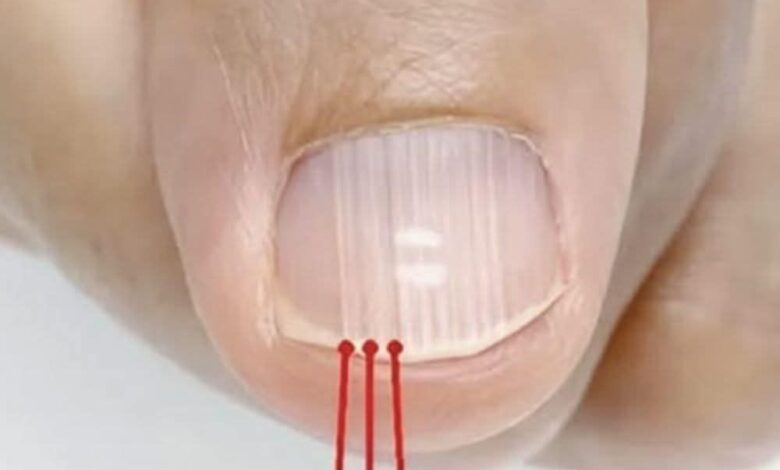Vertical Nail Ridges After 40: What Your Fingernails Are Telling You About Your Health

Are you noticing raised vertical lines running from your cuticle to your nail tip? These longitudinal striations become increasingly common after age 40, and while they’re typically benign, understanding their causes can help you maintain optimal nail health and identify potential underlying conditions.
What Are Vertical Nail Ridges?
Vertical nail ridges, medically known as longitudinal striations, appear as raised lines extending from the nail base to the fingertip. These formations vary in depth and prominence, becoming more noticeable with advancing age due to natural physiological changes in nail structure.
The nail matrix, responsible for producing keratin (the primary nail protein), undergoes gradual changes that affect nail texture and appearance. This process mirrors other age-related changes like decreased skin elasticity and hair graying.
Primary Causes of Nail Ridges After 40
Age-Related Cellular Changes
The leading cause of vertical ridges is the natural aging process. Cellular regeneration slows significantly after 40, affecting nail matrix function. This results in uneven keratin production, creating the characteristic ridge patterns many adults experience.
Nail Dehydration and Environmental Factors
Mature nails lose moisture more readily than younger nails. Frequent exposure to water, detergents, and household chemicals accelerates this dehydration process, making existing ridges more pronounced and contributing to nail brittleness.
Nutritional Deficiencies and Metabolism
Essential nutrients including biotin, iron, zinc, and magnesium play crucial roles in nail health. Age-related changes in metabolism and nutrient absorption can lead to deficiencies that manifest as nail abnormalities, including vertical ridging.
Medical Conditions and Health Indicators
Certain health conditions may contribute to nail ridge formation:
- Thyroid disorders affecting metabolism
- Circulatory issues reducing nail bed nutrition
- Autoimmune conditions like rheumatoid arthritis
- Chronic dehydration or malnutrition
Warning Signs Requiring Medical Attention
While vertical ridges are generally harmless, specific symptoms warrant professional evaluation:
Immediate Concerns:
- Dark pigmentation or unusual color changes
- Horizontal ridges (different from vertical ones)
- Severe nail splitting or separation
- Pain, swelling, or inflammation
- Rapid changes in nail appearance
These symptoms could indicate fungal infections, trauma, nutritional deficiencies, or in rare cases, melanoma beneath the nail bed.
Professional Nail Care Strategies
Daily Maintenance
Implement these evidence-based approaches for healthier nails:
Hydration Protocol: Apply specialized nail and cuticle oils containing vitamin E, jojoba oil, or lanolin twice daily. Focus on the nail bed and surrounding skin to maintain optimal moisture levels.
Nutritional Support: Maintain adequate intake of nail-supporting nutrients through balanced nutrition or targeted supplementation under medical guidance.
Advanced Care Techniques
Gentle Filing Methods: Use glass or crystal nail files, filing in one direction to prevent splitting and further ridge formation.
Professional Treatments: Consider regular manicures with nail strengthening treatments containing formaldehyde alternatives like calcium or protein complexes.
Prevention and Long-Term Management
Lifestyle Modifications
- Wear protective gloves during cleaning or gardening
- Limit exposure to harsh chemicals and acetone-based products
- Maintain consistent hydration (8+ glasses of water daily)
- Include protein-rich foods and omega-3 fatty acids in your diet
Supplement Considerations
Biotin supplementation (2.5-5mg daily) has shown effectiveness in improving nail strength and reducing ridge appearance. However, consult healthcare providers before beginning any supplement regimen, especially if taking medications.
When Professional Help Is Necessary
Schedule a dermatological consultation if you experience:
- Sudden onset of severe ridging
- Ridges accompanied by systemic symptoms (fatigue, hair loss, skin changes)
- Nail changes affecting daily activities
- Concerns about potential underlying health conditions
Conclusion
Vertical nail ridges after 40 are typically a normal part of aging, reflecting natural changes in nail matrix function and keratin production. With proper care, hydration, and attention to overall health, you can minimize their appearance and maintain strong, healthy nails throughout your mature years.
Remember that your nails serve as windows to your overall health. While cosmetic concerns are valid, monitoring changes and seeking professional guidance when appropriate ensures both aesthetic satisfaction and optimal wellness.